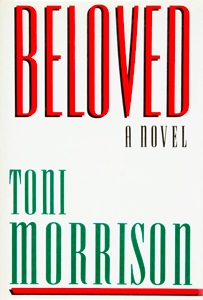Even the horrible things of the past must not be forgotten, lest we repeat them. It’s like Toni Morrison was chosen as a vessel to tell the story of “Beloved” in 1987, 131 years after the story’s post-Civil War but not-quite-post-Slavery events.
The way she tunnels into the lives and speaking rhythms of escaped or freed slaves in the Cincinnati area, a reader can only assume the author was transported back to 1856 and given a chance to be a fly on the wall.
One of the Great American Novels not only in genre but also in achievement, “Beloved” tells the story of Seethe – probably pronounced “Sethy” but I used “Seethe” in my head, not inappropriately – a black woman nearing middle age. Also getting plenty of point-of-view narration are her lover Paul D, her daughter Denver, and the titular newcomer to the rural house dubbed “124,” whose nature provides a mystical mystery.

“Beloved” (1987)
Author: Toni Morrison
Genres: Historical fiction, magical realism
Setting: 1856, rural Cincinnati
Note to readers: The Book Club Book Report series features books I’m reading for my book club, Brilliant Bookworms.
Beloved’s unknown nature (stranger? daughter? ghost?) is the primary refreshing breeze for the reader in what could’ve been a stultifying journey through misery porn. Morrison tells of nightmarish experiences – and how this expands into a nightmarish existence, both outwardly and inwardly – of Sethe via flashbacks to a farmstead called “Sweet Home” in Kentucky and of Paul D on an even worse chain gang in Georgia.
A ghostly window into the past
Readers intellectually know Slavery is the dirtiest of the many stains on American history, but Morrison forces us to emotionally know it. Still, she has sympathy for us. Even in sections about Sethe being raped, Paul D being chained by the neck like an animal, and other awful things happening to black characters (most of it fully protected by U.S. law), we have the pleasure of reading prose that sings like poetry or at least rhythmic chain-gang chants.
“Beloved” – the fifth of Morrison’s 11 novels — is great literature that can be consumed at various depths, although not by very young readers; this is adult stuff. (It makes Banned Books lists, of course, for its sexual content, but – again, of course – it’s humanity’s violence toward other humans that is harrowing.)
Morrison takes the reader by the hand into the nasty shallow waters, but compassionately balances the flow of the narrative. Sethe and Paul D — and Sethe’s mother-in-law, Baby Suggs – are free in Ohio; the worst is behind them, probably. So when we get a flashback, we know we’ll escape back into the present; we know the players have somehow survived.
That having been said, psychological trauma can be generational (the ability of Morrison, who is black, to emotionally tap into this story more than a century removed testifies to that). And even if it wasn’t, Sethe is poor as hell. Denver is in the first free generation of black American citizens, but that doesn’t mean her life is wonderful.

Perspective is important to mental health, and Morrison provides that. This does not hamper the message of the evils of Slavery and racism; it enhances it. We see how fragile this new freedom is, because a black person’s life was fragile in this era.
Relative value
For example, Baby Suggs has a certain monetary value as a slave until she injures her hip; then that value drops, and owner Mr. Garner is therefore willing to sell her to her son, Halle, who gets her moved from Kentucky to Ohio. Morrison points out that it was a business transaction by Mr. Garner, but at the same time, not all slave owners would’ve made that transaction. It’s all relative.
A reader can see how racism can grow in a person’s heart, though not in the direction of white people (“whitepeople” in the book) seeing black people (“coloredpeople”) as subhuman; no white characters get a POV in the book. Rather, Baby Suggs and others have been mistreated by whites in such an amazing variety of ways in their lifetimes that they can’t automatically trust any white person.
Morrison establishes a reality where Sethe can do something universally recognized to be unconscionable and yet the action makes perfect, logical sense within the novel’s hellish context. Then she allows us to ease into further research when we look up information on the novel and find it’s loosely based on a true story (!).
“Beloved” takes a shocking event in American history – even against the backdrop of Slavery, which should be shocking except that it’s so ingrained in the fabric of the country that we’re accustomed to thinking about it (at least in the abstract) – and masterfully turns the players into your basic black family transitioning to “freedom.”
Morrison makes the horrific universal. We’re reminded that for most American blacks in the 19th century, life was awful; it was merely a question of degree. Amazingly, “Beloved” proves that horrific doesn’t have to mean unreadable, or even lacking in literary beauty.

